by Randy Anderson
circa 2009
Julian Buesink - Stock Car Racing Pioneer
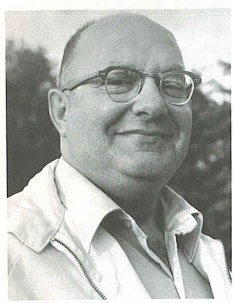
With his 2009 induction, Julian E. Buesink, a pioneer car owner in NASCAR racing, fittingly joined two of his former drivers Lloyd Moore and Bill Rexford, in the Chautauqua Sports Hall of Fame. As Moore once said, "If it wasn't for Julie, neither Bill or myself would have had the racing careers we enjoyed and for which we were recognized." Legendary NASCAR drivers Richard Petty and Cale Yarborough sent letters to the Chautauqua Sports Hall of Fame acknowledging the "hardships and sacrifices Buesink made in the early years to make our sport what it is today".
Buesink was born in the Town of Mina on September 24, 1921, the son of Earl and Bessie Mann Buesink. He was involved in the automoble industry his entire life owning Ford dealerships in Corry, Pennsylvania, Clymer, New York, North East, Pennsylvania, and Westfield, New York, a recreational vehicle dealership, as well as several used car dealerships in the area.
NASCAR Grand National
Buesink's first involvement in NASCAR Grand National racing came just days prior to his twenty-eighth birthday when he entered Bill Rexford, driving a 1949 Ford, in a race at the one-mile track in Langhorne, Pennsylvania. Rexford finished a creditable 14th out of forty-five starters in a race won by Curtis Turner. A week later he and Rexford finished 5th at the NASCAR sanctioned event at the Hamburg (New York) Fairgrounds. On October 2, 1949, Buiesink entered two cars at the Heidelberg (Pennsylvania) Raceway. He was rewarded with a 3rd place finish by Rexford and a 6th place result by Moore in the NASCAR race won by Lee Petty.
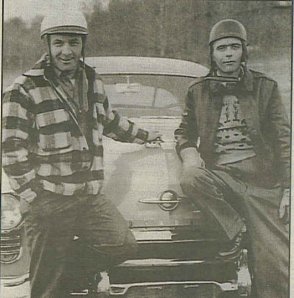
Buesink's team approach to racing in the final race of the '49 season, became his modus operandi in his determined approach to 1950. He entered at least two cars in each of the 17 races on his NASCAR schedule. In races at Dayton (Ohio), Charlotte (North Carolina), Hamburg, Langhorne, and Hillsboro (North Carolina) Julian had three entries and at the inaugural event at NASCAR's first superspeedway, Darlington (South Carolina), Buesink showed with a stable of four cars and drivers. The multi-team concept that is common in present-day NASCAR Sprint Cup, as practiced by owners Rick Hendrick, Jack Roush, and Richard Childress among others, was first introduced to the sport by Julian Buesink in 1950.
The other interesting component to Buesink's 1950 racing plan was his use of several makes of cars. Unlike current NASCAR owners who use only one brand of automobiles, Julian appropriated Oldsmobiles, Lincolns, Fords, and Mercurys for the various lengths of tracks and surfaces his team faced.
Buesink earned NASCAR victories at Canfield (Ohio) on May 30th with Rexford and on October 15th at Winchester (Indiana) with Moore. Other top finishes in the 1950 season for the Buesink team were second place runs by Moore at Langhorne and Vernon (New York), third place results by Moore at Daytona Beach, Canfield, and Vernon, and a third place finish by Rexford at Winchester.
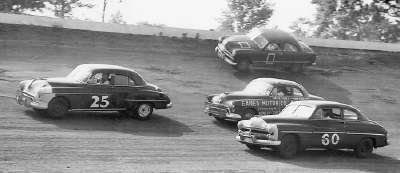
Dayton, OH Speedway. #25 is Dick Linder. The car next to George
Hartley is the great Curtis Turner.
Other drivers piloting Buesink cars in 1950 besides Rexford and Moore were Jim Paschal and George Hartley. Paschal would go on to have a twenty-three year NASCAR Grand National career scoring 25 wins, 12 poles, and 230 top-ten finishes in 421 starts. In total, Buesink entered 42 cars in 17 races. He earned two wins, twelve top-five finishes and 23 top-ten results.
When the final NASCAR points were tabulated, Bill Rexford was declared the Grand National Champion over Fireball Roberts and Lee Petty with Lloyd Moore edging out Curtis Turner for 4th place. Rexford, from Conewango Valley, New York, who was just 23 year old at the time, remains the youngest champion in NASCAR Sprint Cup history and its only champion from New York State.
Bill France, Sr., President of NASCAR, recognized Julian Buesink as its National Champion Car Owner of 1950. Speed Age magazine honored Buesink for "outstanding achievement as stock car racing's Car Owner of the Year." An article in the magazine contained the following:
"Buesink tried every make of car he felt practicable, and soon discovered it took a different make for each kind of track. His stable finally became composed of Fords, Mercurys, Oldsmobile 88s, and Lincolns. He contracted two drivers Bill Rexford of Conewango Valley, NY and Lloyd Moore of Frewsburg, NY and sometimes used another, George Hartley of Erie, PA.Traveling from Canada to Florida, wherever the NASCAR circuit operated, Buesink played his cars as one would play chess. He decided the type of car for a particular track, then furnished that make for his drivers. If his judgment was faulty he lost, if right he won.
"That he won more than he lost showed in the final NASCAR tabulation. His drivers, Rexford and Moore, finished as champion and fourth in the national standings, a combination of finish places not neared by any other stable of cars.
"For his belief in stock car racing, and performance of his stable of cars, Julian Buesink of Findley Lake NY has been named by the voting panel for the first annual Speed Age Magazine Award as the Outstanding Car Owner in 1950 for the stock car field."
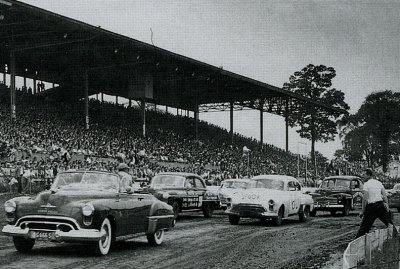
Dayton, OH Speedway. #25 is Dick Linder. The car next to George
Hartley is the great Curtis Turner.
In 1951 as defending champion, the Buesink team again attacked the NASCAR circuit. He entered fifty-one cars in 31 events with Moore as his lead driver. Julian fielded two cars at Hillsboro, North Wilkesboro (North Carolina), Martinsville (Virginia), Columbia (South Carolina), Dayton, Grand Rapids (Michigan), Bainbridge (Ohio), Weaverville (North Carolina), Rochester (New York), Detroit (Michigan), Morristown (New Jersey), Darlington, Thompson (Connecticut), and Jacksonville (Florida). Three-car teams were entered at Daytona Beach, Charlotte, and Canfield.
Drivers wheeling the Buesink Fords and Oldsmobiles in '51 were Moore, Paschal, Rexford, Don Eggett, Harold Kite, Jimmie Lewallen, Dean Sprague, Ted Swaim, and even Julian himself.
At Thompson Speedway on October 12, 1951 Julian drove in his only race starting 17th and finishing 27th in the field of 38.
Best results for the Buesink team in '51 were a pole position start for Rexford at Canfield, a third for Moore at Dayton, and a third for Paschal at Macon (Georgia). Moore finished 11th in the 1951 NASCAR National Point Championship.
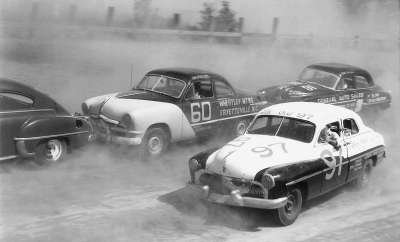
Georgia where he finished third.
After two grueling seasons of following NASCAR from Canada to Florida and from the Mississippi to the Atlantic, Julian began to curtail his racing efforts by adopting a "pick and choose" schedule. In 1952 he entered just 15 races with a single car effort. Moore was in the seat eight times, Pachal six, and Rexford once. The best finish of the Grand National season was a second by Moore behind Dick Rathmann and ahead of Tim Flock at Dayton on May 18th.
Although Buesink concentrated most of his efforts towards the newly formed Mid-American Racing Circuit (MARC) in 1953, he entered Bill Rexford in NASCAR races at Langhorne (10th) and Rochester (5th). In addition, this writer believes Julian was also the car owner of the third place finisher of the 1953 Daytona road-beach race, Tommy Thompson, although Thompson was listed as the owner in the race record. A photo taken before the start of the race, clearly shows the fourth starting Thompson in a 1953 Lincoln with "Buesink" emblazoned across the hood.
Buesink did not participate in any NASCAR Grand National races in 1954.
In what turned out to be Lloyd Moore's final year of competition, 1955, Buesink fielded cars for him at Raleigh (North Carolina) and Darlington. Tommy Thompson was Moore's Darlington teammate in a second Buesink machine.
Following the retirement of Moore, Buesink hired Warren, Pennsylvania, driver Bob Duell. The duo competed in six NASCAR GN events in 1956 with their best showing being at the Monroe County Fairgrounds in Rochester. Duell set second fastest time during qualifications and then steered the '56 Ford to a fifth place finish behind Speedy Thompson, Jim Paschal, Herb Thomas, and Buck Baker.

The following year, 1957, Julian entered Duell in five NASCAR GN races. Their best effort was at the half-mile dirt oval Lincoln Speedway in New Oxford, Pennsylvania, where Bob qualified the Buesink '57 Ford 7th. A broken rear-end relegated the team to a 13th place result.
On June 12, 1958, Duell set fast time in Julian's Ford at the NASCAR sanctioned grand opening of the New Bradford Speedway in Bradford, Pennsylvania. Duell brought the #95 home in third place behind superstars Junior Johnson and Lee Petty. A month later, Stateline Speedway in Busti, New York held its first and only NASCAR race and the Buesink-Duell team finished 2nd behind Shorty Rollins, who would go on to win NASCAR Rookie-of-the-Year honors for 1958. Julian entered Duell in five other NASCAR GN races that year that included a respectable 5th place result at Rochester following Cotton Owens, Buck Baker, Speedy Thompson, and Lee Petty.
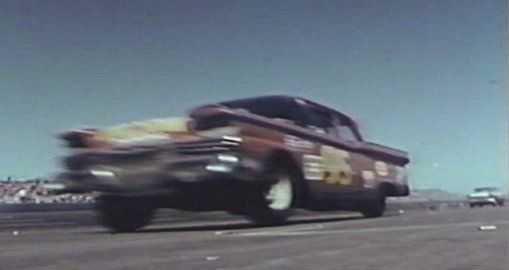
Duell drove Buesink's Ford in four NASCAR GN events in 1959 with his best finish being 11th at Weaverville, North Carolina. For the Southern 500 at Darlington, Buesink teamed Duell with an eighteen-year-old rookie by the name of Buddy Baker, son of Buck Baker. Buddy Baker, who along with his father, was named as one of NASCAR's Fifty Greatest Drivers, had a 33 year Grand National career scoring 19 wins, 38 poles, and 311 top-ten results in 699 races.
Buesink and Duell combined for six appearances on NASCAR's premier circuit in 1960. Their best effort was an 8th on the two-mile road course at the Montgomery Air Base in Montgomery, New York. The first five finishers were legendary drivers Rex White, Richard Petty, Lee Petty, Ned Jarrett, and Buck Baker.
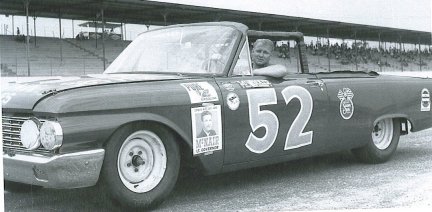
The next year Julian hired Tom Dill to drive his '61 Ford at Daytona and Darlington. Dill finished 18th in the second of two 100 mile qualifying races for the Daytona 500. In the third annual Daytona 500, Dill brought Julian's 1961 Ford home in 17th position to earn $325.Later that year, Buesink gave a 21-year-old daredevil from South Carolina, making his fourth ever NASCAR start, a ride in the #52 machine at the Darlington Labor Day classic. His name was Cale Yarborough. Cale would go on to be a three-time NASCAR GN champion and was named as one of NASCAR's Fifty Greatest Drivers. Yarborough captured 83 wins, 70 poles, and 319 top-ten finishes in 560 races during his thirty-one year career.
In 1962 Buesink and Yarborough teamed up for four NASCAR GN events at Daytona, Darlington, and Atlanta. Cale brought the #52 Ford home 10th in one of two qualifying races at the two and a half mile Daytona International Speedway.
Buesink competed for the final time in NASCAR GN competition in 1963. He had Yarborough in the seat at Daytona and Darlington. Julian tabbed Rene Charland, NASCAR Sportsman Champion in 1962, to drive his #52 in a Grand National consolation race at Daytona when Yarborough was too ill to drive. Unfortunately Charland tangled with Ralph Earnhardt resulting in a massive crackup that eliminated many cars. Julian's last GN race was May 11, 1963 at the Rebel 300 in Darlington where Cale came home 11th. Joe Weatherly, Fireball Roberts, Richard Petty, and Tiny Lund occupied the top four positions.
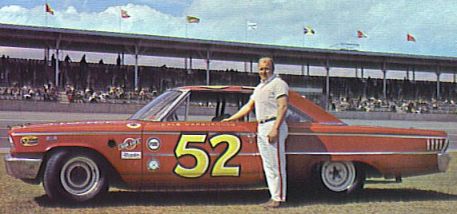
In thirteen total years of NASCAR Grand National competition, Julian Buesink competed in 107 races, entering 156 cars, driven by 15 drivers. He earned two pole positions, won two races, had 29 top-five finishes, 64 top-ten results, and earned $42,841 in race purses. Most significant was his GN Championship in 1950.
NASCAR Convertible Division
Buesink also briefly dabbled in NASCAR's Convertible Division. The "Rumblin'Ragtops" were sanctioned by NASCAR from 1956 to 1959. Buesink entered two convertible events in 1958 with his '58 Ford ragtop. Fireball Roberts drove the #95 at the Daytona Beach beach-road course, but was sidelined after only eleven laps by overheating. Shorty York jumped in the seat for the Rebel 300 at Darlington and ended up in 21st spot. Curtis Turner won both of the convertible races that Buesink contested.
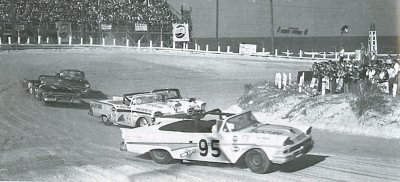
road/beach course, 1958.
NASCAR Sportsman Division
February 10, 1951, on the 4.1 mile beach-road course at Daytona, NASCAR sanctioned a 39 lap race for its Sportsman Division cars. Sportsman cars differed from the top-level Grand National cars. They were generally older cars that had been slightly modified for racing, unlike the showroom stock GN cars. Buesink prepared a '39 Ford for Rexford and a '49 model for Moore. Ninety-one cars started the event that saw Rexford finish 13th and Moore 20th. Gober Sosebee, Frankie Schneider and Tim Flock captured the top three places.
NASCAR Short Track Division
In the '50s NASCAR also sanctioned races at racetracks less than a half-mile in length through its Short Track Division. Although most records of races from that era have been lost, some documentation exists that shows Buesink entered cars in this division as well. Llyod Moore won a 100-lap race at the quarter-mile Canfield Speedway in Buesink's '50 Ford on September 27, 1951.
After competing in a GN race at Thompson, Connecticut, on October 12, 1951, Buesink and Moore towed to Westport Stadium in Baltimore, Maryland for a short track race on October 13th, and then high-tailed it to Shippenville, Pennsylvania, for another GN race on October 14th. This road trip was all accomplished without the benefit of modern highway systems.
In 1951, Moore and Buesink competed in short track races at the quarter-mile asphalt that was called Victory Stadium at Roanoke, Virginia, earning an 11th place finish on June 12th and at the quarter-mile Lanham Speedway in Lanham, Maryland on July 18th finishing 8th. Both of these two NASCAR Short Track Division races were captured by Lee Petty.
The final NASCAR Short Track that this writer has uncovered for Buesink and Moore came at Mercer (Pennsylvania) on May 20, 1953. During the 250-lap race on the quarter-mile dirt surface, Moore became overcome with fumes from the car's exhaust and had to be relieved by Fonty Flock who brought Julian's machine home in 9th place.
As mentioned above, records from this division of NASCAR are scarce. It is this writer's opinion that Julian Buesink likely entered cars in many other Short Track Division races.
Midwest Association for Race Cars (MARC)
In 1953 John Marcum of Toledo, OH a former promoter of NASCAR races broke away from the Bill France led organization to form a new stock car circuit called Midwest Association for Race Cars or MARC. Julian Buesink quickly aligned himself with Marcum and his new circuit, completely eschewing any NASCAR races in 1953 or 1954.

Similarly to the NASCAR Short Track Division previously mentioned, records for the early days of MARC are incomplete. Recently, however, local auto racing fan and former Buesink crewman in the 60's, Dennis Goggin from Clymer researched microfiche of the racing newspaper National Speed Sport News and uncovered some results of Julian Buesink's involvement in MARC.
In 1953 Julian entered Lloyd Moore, driving a 1953 Ford, in at least 11 races with very good success. Moore had second place finishes at Jefferson (Ohio) and Kokomo (Indiana), thirds at Dayton (Ohio) and Kittaning (Pennsylvania), and fourths at Akron (Ohio), Canfield (Ohio), and Dayton (Ohio).
The following year, Buesink and Moore competed in at least five MARC events. Their crowning achievement of '54 was capturing the Metropolitan 300 race at Dayton Speedway on June 6th. Moore led 251 laps to top future NASCAR competitor Bob Welborn and 1953 MARC champion Jim Romine. Other good runs for Moore/Buesink that year were a third at Bedford (Ohio) and fourths at Dayton and Detroit.
In addition to their two NASCAR appearances, Buesink and Moore entered at least four MARC races in 1955. Their best finish was a fourth at the Ohio State Fairgrounds track in Columbus.
Bob Duell replaced the retired Moore in Buesink's cars in 1956. In addition to their NASCAR schedule, they also entered at least two MARC races, including a 5th place result at Dayton.

Duell made at least two starts for Julian in both 1957 and 1958 MARC action, followed by six in 1959 and four more in 1960. Notable results were a third at Langhorne on April 19, 1959, another third at Dayton on June 7, 1959, a second at the Michigan State Fairgrounds in Detroit on September 11, 1960, and a fifth at Canfield on May 30, 1960. Tom Dill also drove in one MARC race for Julian in 1960.
A particularly interesting event during the 1960 season came at the Eldora 500 race at the half-mile dirt oval in Rossburg, Ohio. Duell was scored in second place at the end of the race, but when it was discovered he had completed the 250 miles making only one pit stop, third place finisher Mike Klapak lodged a protest. MARC rules limited the gas tank capacity to 23 gallons, but MARC officials were able to pour 24.8 gallons into Duell's tank. He was disqualified and officially scored 39th.
For the '61 season Buesink fielded MARC cars in at least five MARC events using drivers Bob Duell and a bodyman at his Clymer Ford dealership named Marty Rater. Duell had a fourth at Powell (Ohio) and a fifth at Canfield. Rater set fast time at Fremont (Ohio) before settling for a 7th place result.
Tom Dill drove Buesink's Ford in at least one MARC race in '62 scoring a 7th at Canfield. The next year found Dill and Findlay Lake's Pat Moore competing in at least two MARC events for Julian.
Automobile Racing Club of America (ARCA)

scheduled to drive, but was replaced by Jack
Shanklin.
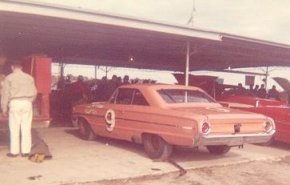
For the 1964 season MARC changed its name to the Automobile Racing Club of America (ARCA). Mike Klapak wheeled Julian's car to a pair of top ten finishes at Daytona in February. On April 5th, Dill drove Buesink's 1964 Ford to victory in the Americana 300 at International Raceway Park in Ona, West Virginia. The win came amidst controversy, however. With a fourteen second lead, Dill blew a right front tire on the 298th lap. Rather than pit, Dill nursed the #9 the final two laps narrowly edging Virgil Barbe and Elmer Musgrave. A dispute arose when Musgrave pulled his car into the winner's circle claiming he had lapped Dill twice. A check of the scoring cards proved to be inconclusive and the Dill/Buesink team received the $1250 first place check.
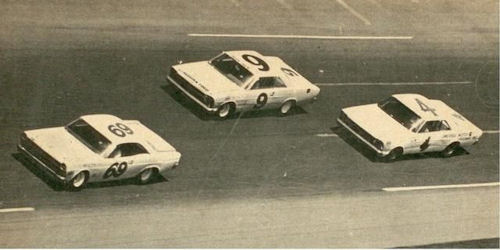
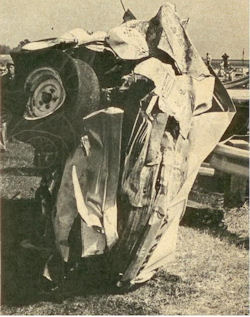
in 1967.
Jack Shanklin of Indianapolis took over the controls of Buesink's Ford for the Daytona ARCA race in 1965 while Jamestowner Floyd Fanale was in the seat for at least five races in '66, including a four race swing through Texas. Shanklin then demolished the #9 at the Daytona ARCA race in 1967.
Jim Scott from Garland, PA took over driving duties for the ARCA races at Daytona in '68, '69, '70, and '71. He also wheeled the car at Talledega's ARCA race in 1969. Scott had three top ten qualifying efforts and one top-ten finish in his five starts.
Julian's final ARCA race was at Daytona in 1974 with Blackie Watt at the controls of a 1973 Ford, but a blown engine ruined their day.
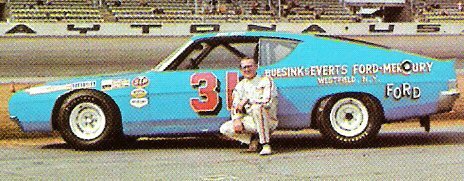
As mentioned earlier, MARC/ARCA records from the 50s and 60s are sketchy at best. It is likely Buesink entered races in addition to those reported here.
Unsanctioned Local Racing
Not only was Julian Buesink a major player on the national auto racing circuits, his cars and drivers were stout competition at the various unsanctioned stock car tracks. In the early 50s, Buesink, with Lloyd Moore at the controls, competed at Sportsman's Park in Erie, the Chautauqua County Fairgrounds in Dunkirk, the Civic Stadium in Buffalo, and tracks in Portville (New York), Clearfield (Pennsylvania), and Butler (Pennsylvania). Moore once won three consecutive races at the Erie oval. But primarily, for most of the 50's, Julian concentrated on the NASCAR and MARC schedules.

For 1961 Buesink became a car owner on the Stateline Speedway and Eriez Speedway circuit fielding a car that Marty Rater and Freddy Knapp shared. Knapp won his first-ever late model feature at Stateline on July 1, 1961 in Julian's machine. Four weeks later Bob Duell slipped behind the wheel and again put Buesink #52 in victory lane for the 50-lap Mid-Season Championship. This time, however, Frank Ruhlman, owner of the car shared by Hyle Russell and Eddie Kisko cried foul. He put up a $25 protest fee to have the rear end of the Buesink car torn apart. Ruhlman claimed the racecar had an illegal locked rear-end. After an inspection process that was observed by over 250 people, Stateline track owner Len Briggs declared Buesink's car "all legal and above board".
Rater was again the Stateline/Eriez driver in 1962 scoring a season best second place at Stateline on May 18th. Pat Moore took a turn in the cockpit for 1963 scoring a season best third on July 6th.
Paul Wilson gave Buesink a win at Stateline on June 6, 1964 followed by a second on July 25th.
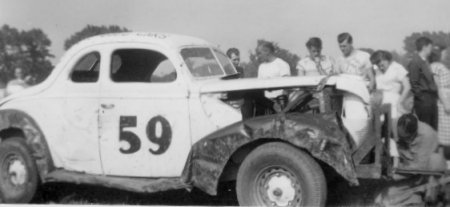
wearing a t-shirt, with his head turned. Julian Buesink is in front of the
car adjusting the tow bar.
For 1965 Buesink utilized a two-car team at Stateline and Eriez employing Freddy Knapp to drive his #99 and adding Floyd Fanale near mid-season to steer the #9. Knapp scored two wins at Eriez, a 25-lapper July 25th and the 100-lap season finale on September 19th. He also recored six other top-three finishes in Julian's '64 Ford. Fanale rewarded Buesink with a Stateline win in July 31st and then followed his teammate across the finish line in the Eriez season-ender.
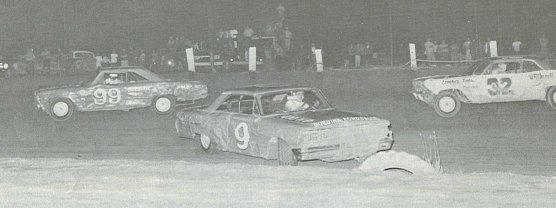
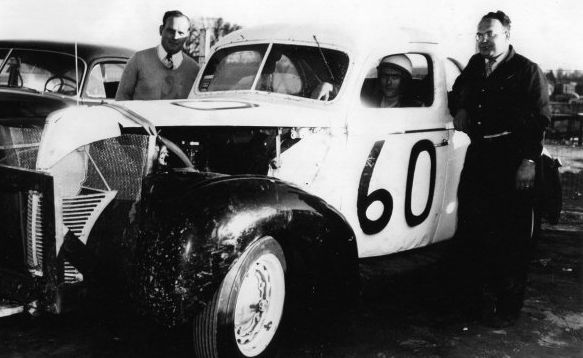
Knapp and Fanale returned as Julian's drivers in 1966. Knapp took first place in a 50-lapper at Eriez on May 29th, a 25-lapper at Stateline on July 30th, and repeated in the 100-lap Grand Championship race at Eriez on September 11th. Meanwhile, Fanale added a win at Eriez on May 15th.

Julian Buesink, and driver Freddy Knapp
after a win at Stateline on July 30, 1966.
Jim Scott led a single car effort for Buesink in 1967. "Jimbo" grabbed two feature wins at Eriez, June 11th and July 9th, and added five other top-three finishes in Julian's '64 Ford, now numbered "3". He finished second to Bobby Schnars in the final Stateline point standings.
The next year Buesink gave Scott a brand-new car, a 1968 Ford Torino, and Scott repaid his owner by having a monster year. Jim copped eleven top-three finishes including five feature wins. Twenty-five lap events fell to the #3 Torino at Stateline on June 22nd and July 13th, followed by a 50-lap score on July 27th, and culminating with a victory in the 100-lap Grand Championship race on August 31st. However the biggest accomplishment of the season was Scott's dominating win in the Eriez 150 that brought a check for $2,087. The victory came after the Buesink crew worked eighteen straight hours rebuilding the engine that had swallowed a piston the night before at Stateline. When the final points were tabulated for the year, Scott was the Eriez track champion, the fourth-place man at Stateline, and third on the overall Stateline/Eriez Circuit.
Jim Scott returned as the "shoe" of Buesink's Torino Cobra in 1969. Together they produced seven top-three finishes including wins at Eriez on June 29th and August 24th. Final point listings found Scott fourth at Eriez, fifth at Stateline, and fifth on the S/E Circuit.
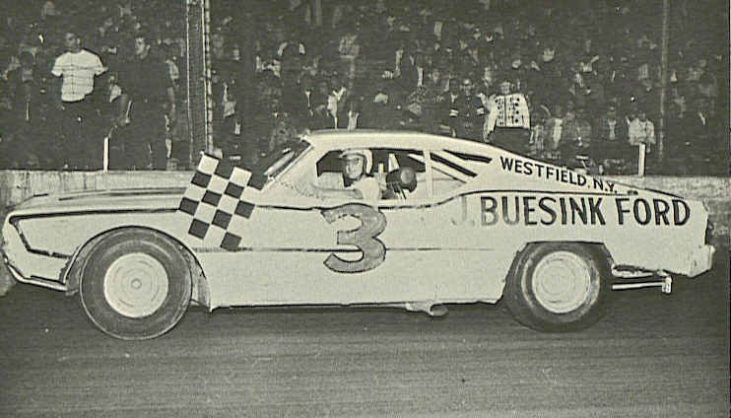
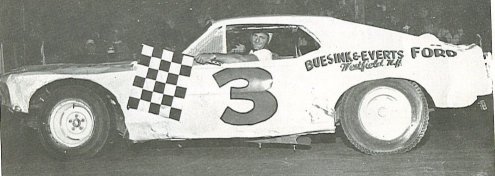
A Ford Mustang came from the Buesink garage in 1970 for Jim Scott to drive. Scott piloted the machine to eight top-three results, including victories at Stateline on June 27th and July 11th, and a score at Eriez on June 28th. However, during an event at Eriez on July 26th, Scott hit an errant wheel from another car that catapulted his Mustang into the air. The subsequent landing broke Jim's back. While recovering from the injury, Buesink replaced Scott with "The Flyin' Farmer", Johnny Whitehead, who produced a second place result at Eriez on August 23rd.
Buesink came back with a two-car effort in 1971 putting Freddy Knapp in the #99 Mustang and the recovered Jim Scott in the #3 Torino. Knapp and Scott combined for nine top-three finishes including a victory by Freddy at Eriez on May 16th. Scott completed the year fourth in Stateline points and fifth on the S/E Circuit.
Knapp was the pilot of Julian's #9 Mustang for 1972 and 1973. He was first under the checkered flag at Eriez on May 21, 1972 and July 8, 1973. Knapp garnered four other top-three results.
During the period 1961-1973 when Buesink competed on the Stateline-Eriez Circuit, he would also show at other local stock car tracks. However lack of records prevents a chronicling of those efforts.
Following the 1973 season, Julian's racing career was essentially over. Although he would occasionally sponsor a car, in particular that of his son Alan, as late as the 1990s, he refocused his attention and energy to his businesses.
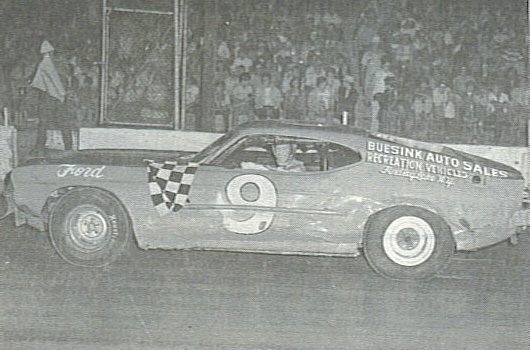
Buesink's career totals on the Stateline/Eriez Circuit are 27 feature wins and 73 top-three finishes.
Personal
Julian Buesink married Jean Hagelin in 1947. Their marriage produced four daughters Beverly, Darlene, Vicki, and Julie, along with a son, Alan.
Julian was a former supervisor for the Town of Mina. He was a member of the Findley Lake United Methodist Church.
Buesink died on September 23, 1998 and was buried in Mina Cemetery.
In his own words
In honor of his many contributions to the sport, Buesink was invited to Daytona Beach to appear at the 3rd Annual Legends Banquet and Parade in 1977.
"Legends?" joked Julian. "Everybody here is just old and tired."
"We didn't really realize what NASCAR would come to. If we would have, we would have saved some of the racecars. We didn't realize how big it was going to become."

"It cost a lot of money, but I learned a lot and have a lot a memories."
Buesink recalled the time his driver Lloyd Moore wheeled his Ford from the tail of the field to second place in just 25 laps at Canfield.
"I thought I was going to have a heart attack. The car looked like it had been through a war, but I had the biggest thrill of my life. I'll never forget that race."
With his 2009 induction into the Chautauqua Sports Hall of Fame, Julian E. Buesink's contributions to the sport of automobile racing on the national, regional, and local stages will not be forgotten.
The additional financial assistance of the community is critical to the success of the Chautauqua Sports Hall of Fame.
We gratefully acknowledge these individuals and organizations for their generous support.













